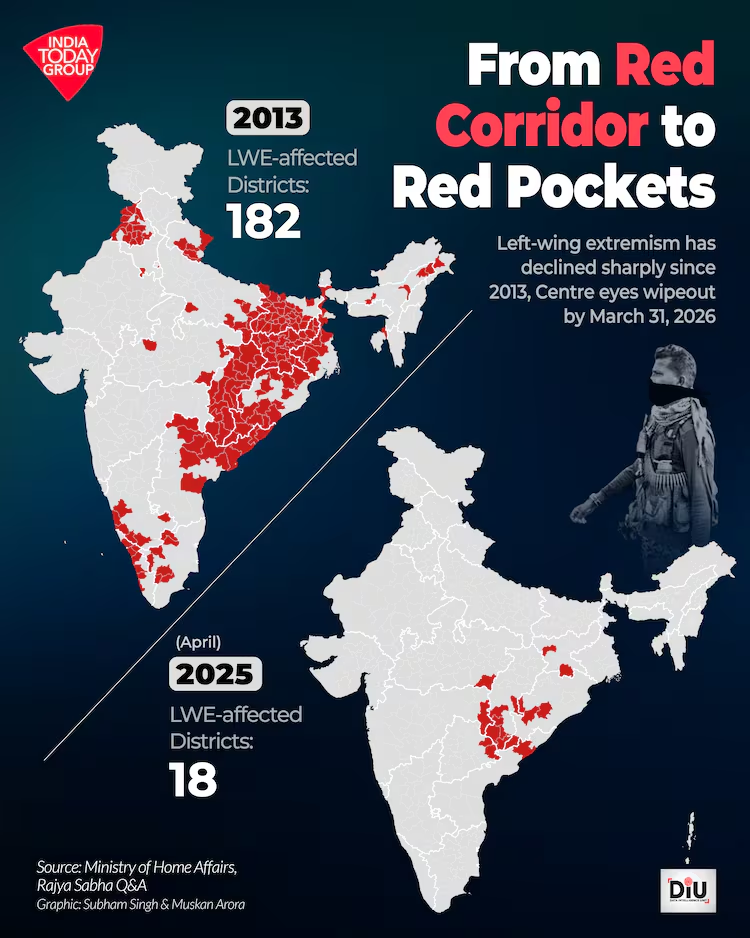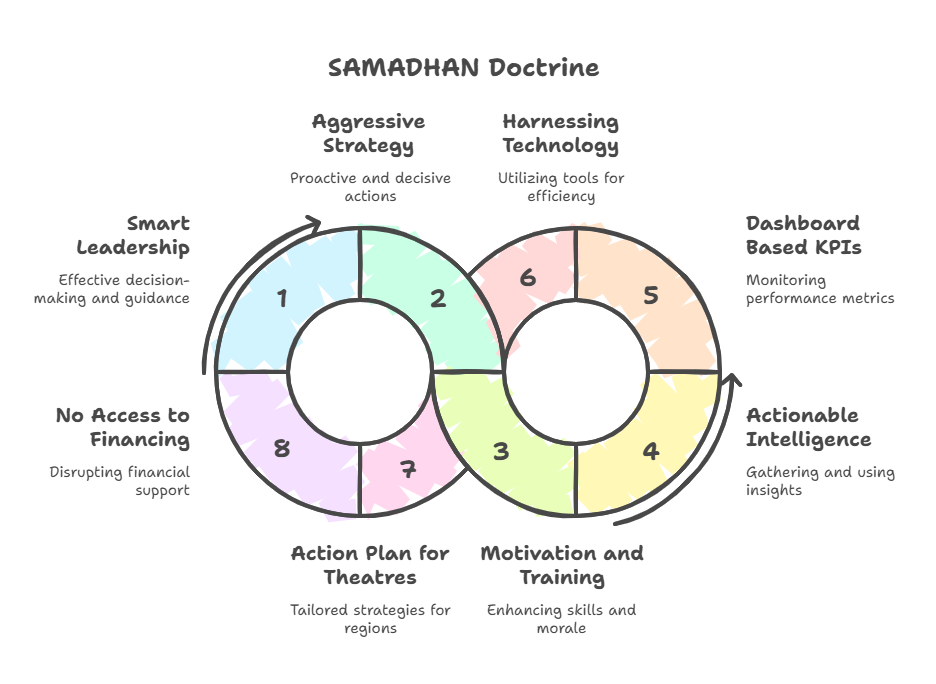Internal Security
Unraveling the Roots of LWE in India
This editorial is based on “Left Wing Extremism is a smokescreen. Maharashtra’s new law could criminalise dissent” which was published in The Indian Express on 25/07/2025. The article brings into picture the risks of Maharashtra’s new bill on Left Wing Extremism blurring the line between dissent and violence, while emphasizing that lasting solutions lie in addressing the socio-economic roots of extremism rather than relying solely on punitive measures.
For Prelims: National Investigation Agency, Red Corridor, Dharti Aaba Janjatiya Gram Utkarsh Abhiyan, SAMADHAN doctrine, Eklavya Model Residential Schools, GIS mapping, Operation Black Forest.
For Mains: Key Breakthroughs of India in Combating Left Wing Extremism, Key Factors Behind Persistence of LWE in India.
The Maharashtra legislature's recent bill targeting Left Wing Extremism (LWE) reflects a broader national challenge in addressing ideological violence while preserving democratic freedoms. The legislation's definitions and expansive scope risk criminalizing legitimate dissent and criticism, blurring the lines between violent extremism and constitutional rights to free expression. Rather than relying solely on punitive legislation with unclear boundaries, India must focus on dismantling the socio-economic roots that fuel extremism—addressing inequality, governance failures, and developmental deficits that create fertile ground for radical ideologies.
What are the Key Breakthroughs of India in Combating Left Wing Extremism?
- Enhanced Intelligence and Counter-Terrorism Capabilities: The strengthening of India’s intelligence capabilities has been crucial in breaking the backbone of LWE groups.
- With the creation of the National Investigation Agency (NIA) and an uptick in joint intelligence-sharing between states, the security forces have managed to neutralize 290 Maoists in 2024 alone.
- The significant enhancement of Special Intelligence Branches and fortified police stations has bolstered the capacity to target and dismantle insurgent networks.
- Strategic Military Successes and Tactical Operations: India’s security forces have shown increased operational success against Maoist factions.
- For instance, the Karreguttalu Hill operation (Operation Black Forest) in 2025, which led to the neutralization of 31 Maoists with zero casualties on the side of security forces, exemplifies the efficiency and precision of counter-LWE operations.
- Over 8,000 Maoists have surrendered over the last decade, reflecting how military pressure has forced many insurgents to abandon violence and reintegrate into society.
- Bilateral Cooperation Between States: Cooperation among LWE-affected states has played a pivotal role in reducing Maoist influence.
- The coordinated operations between Chhattisgarh, Jharkhand, and Odisha led to the dismantling of key Maoist strongholds in the Red Corridor.
- The geographical spread of LWE violence has also constricted substantially with reduction of LWE affected districts from 126 across 10 states in 2013 to only 38 districts in 2024 across 9 states, demonstrating the positive impact of strong interstate cooperation.
- These states share intelligence, resources, and conduct joint operations, ensuring a unified front against the insurgency.
- Community-Based Peacebuilding and Civic Programs: Civic action programs have helped in Winning Hearts and Minds (WHAM) of local populations and reducing support for Maoists.
- The Civic Action Programme (CAP), with a budget of ₹196 crore for the last five years, has helped build a rapport between security forces and local communities.
- Tribal Youth Exchange Programs (TYEP) have also fostered social integration by providing tribal youth with opportunities to engage with the mainstream culture, reducing Maoist recruitment in tribal areas.
- Holistic Rehabilitation for Former Maoists: India’s emphasis on rehabilitating former insurgents through targeted rehabilitation programs has been crucial.
- The Chhattisgarh government’s surrender policy, which offers financial support and vocational training along with increased compensation, land and job opportunities, has successfully reintegrated former militants back into society, depriving the insurgency of critical human resources.
- Targeted Welfare and Development Schemes: The government has launched tailored welfare initiatives to uplift the most vulnerable populations in LWE-affected regions.
- The “Dharti Aaba Janjatiya Gram Utkarsh Abhiyan”, launched in October 2024, aims to provide basic amenities to 1.5 crore tribals across 15,000 villages.
- Enhanced infrastructure projects, such as the construction of over 17,000 km of roads and 7,768 telecom towers, indicates that security and development go hand-in-hand.
- Additionally, Rs. 3,563 crore has been allocated under the Special Central Assistance Scheme (SCA) for bridging infrastructure gaps in these regions, ensuring that the local populations are less dependent on Maoist-controlled systems.
- Empowering Local Governance and Law Enforcement: The empowerment of local police forces has played a crucial role in the government’s success.
- 612 fortified police stations, up from 66 in 2014, have provided much-needed infrastructure to local law enforcement.
- The Security Related Expenditure (SRE) scheme has provided ₹3,260 crore in operational funding to affected states, facilitating the modernization of police forces.
- These efforts have enabled state police to take the lead in counter-LWE efforts, reducing the reliance on central forces and improving local security control.
What are the Key Factors Behind Persistence of LWE in India?
- Socio-Economic Inequality and Marginalization of Tribal Communities: The persistence of Left Wing Extremism (LWE) is largely due to deep-rooted socio-economic inequalities, particularly among tribal communities.
- Despite government initiatives, regions most affected by LWE remain economically backward, lacking basic services like education, healthcare, and infrastructure.
- For instance, according to a report by the Ministry of Tribal Affairs, Government of India, only 10.7% of the tribal population has access to tap water, highlighting a significant gap in basic infrastructure.
- State-Society Disconnect and Governance Failures: In many LWE-affected areas, there is a significant disconnect between the state and local populations, often exacerbated by weak governance and poor law enforcement.
- The lack of adequate policing and administrative presence in these regions allows Maoists to exploit governance gaps.
- For instance, remote areas of Jharkhand and Madhya Pradesh still lack basic police stations.
- This absence of governance structures creates a vacuum that Maoists fill, enabling their influence to persist.
- Maoist Ideology and Resistance to Mainstream Politics: The ideological appeal of Maoism remains strong in certain regions, as it positions itself as a revolutionary alternative to India's democratic institutions.
- Maoist groups claim to fight for the rights of the oppressed (jal jangal jameen), particularly tribals, yet their methods, including wrongdoings and extortion, hinder development.
- For instance, in Odisha's Malkangiri district, Maoists have been reported to extort money from villagers involved in illegal cannabis cultivation.
- This illicit activity not only funds the insurgency but also entangles local communities in criminal enterprises, further hindering lawful economic development.
- Resource-rich Areas Fueling LWE: Critics argue that LWE thrives in resource-rich regions where exploitation by both the state and private corporations has led to widespread discontent.
- The extraction of resources like coal, minerals, and timber in Chhattisgarh and Jharkhand has often displaced indigenous populations without adequate compensation.
- For example, in Hasdeo Arand, tribal leaders have raised concerns over coal mining, which leads to displacement and loss of livelihoods.
- Maoists capitalize on this exploitation narrative, portraying themselves as defenders of local rights against corporate greed.
- Inadequate Implementation of Development Schemes: While India has implemented several development schemes to counter LWE, the ground-level execution remains inadequate.
- Programs targeting infrastructure, health, education, and financial inclusion often fail to reach remote regions due to corruption, inefficiency, and lack of political will.
- For instance, although 17,589 km of roads have been constructed under the Road Requirement Plan, many LWE-affected areas in Madhya Pradesh and Odisha still remain inaccessible, enabling Maoist forces to operate freely in those pockets.
- The delayed or improper execution of welfare schemes stunts the growth of these areas, allowing LWE to persist.
- External Support and Funding for Maoist Groups: Maoist insurgents continue to receive both internal and external support, both in terms of resources and ideological backing, which perpetuates the movement.
- This external backing enables the insurgents to operate despite the government's counter-insurgency operations.
- For instance, a Kerala-based individual was arrested for allegedly trying to set up a Maoist-controlled NGO network in Jammu and Kashmir.
- Also, in the recent past, China and Myanmar were accused of providing both ideological and material support to Maoist insurgents in India.
- Recruitment of Youth and Use of Guerrilla Tactics: Maoist insurgents have managed to recruit youth, particularly from tribal regions, by offering an outlet for frustration and discontent.
- For instance, the People’s Liberation Guerrilla Army (PLGA), the armed wing of CPI (Maoist), continues to carry out sophisticated guerrilla warfare tactics, making it difficult for security forces to gain full control.
- Although over 8,000 Maoists surrendered in the past decade, Maoists still manage to sustain their ranks through continued recruitment of young tribals who face limited opportunities in their communities.
What Measures can India Adopt to Dismantle the Roots of LWE in India?
- Strengthening Local Governance and Decentralized Administration: To dismantle the roots of Left Wing Extremism (LWE), India must focus on empowering local governance structures, particularly in remote and tribal areas.
- Decentralized administration can facilitate faster responses to grievances and ensure that development schemes reach the grassroots level.
- Empowering local leaders and increasing their involvement in decision-making would ensure that the concerns of tribal and marginalized communities are addressed promptly, thereby reducing the appeal of extremist ideologies.
- A more localized approach would also enhance accountability and transparency in governance.
- Enhanced Focus on Social Justice and Land Reforms: A comprehensive social justice framework is critical for addressing the grievances that fuel LWE.
- Land reforms, particularly the redistribution of land to tribal communities, would provide a sense of ownership and security to marginalized groups.
- Strengthening the implementation of the Forest Rights Act, which ensures tribal communities' rights to forest land, can address historical injustices and provide economic stability.
- Promotion of Rural Employment and Livelihood Programs: To counter the economic factors driving youth towards Maoist insurgency, India must scale up rural employment and livelihood programs.
- Focusing on creating sustainable livelihoods, particularly in LWE-affected areas, would reduce dependency on illegal activities.
- This could be achieved by integrating tribal youth into the broader economic framework through vocational training, entrepreneurship programs, and community-driven agriculture models.
- Intensifying SMART and Community Policing and Building Trust: Community policing initiatives can create stronger ties between law enforcement and local populations, making it harder for extremist elements to thrive.
- Security forces should engage in civic action programs that go beyond counterinsurgency operations and focus on community welfare, trust-building, and conflict resolution.
- In line with the SMART Police vision—Strict and Sensitive, Modern and Mobile, Alert and Accountable, Reliable and Responsive, Tech-savvy and Trained—such efforts should be strategic and people-centric, fostering accountability and trust in conflict-affected regions.
- Strategic Anti-Maoist Ideological Campaigns: India needs a concerted, well-planned ideological counteroffensive to challenge the narratives spread by Maoist groups.
- This could involve launching nationwide awareness campaigns that focus on the destructive impact of violence, particularly on tribal populations.
- Collaborating with local influencers, activists, and intellectuals who are not aligned with Maoist ideology would help promote peace, democracy, and the benefits of development.
- Such campaigns should focus on empowering communities with knowledge of their rights and the state's willingness to address their concerns peacefully.
- Streamlining and Expanding Infrastructure Projects: The government should fast-track the completion of infrastructure projects in LWE-affected areas, particularly those related to road connectivity, telecommunications, and electricity supply.
- Access to improved infrastructure helps to break the isolation that LWE groups thrive on.
- This will also aid in integrating remote areas into the national economy and providing access to education, healthcare, and markets.
- Expedited infrastructure development, alongside public-private partnerships, can ensure that rural areas are not left behind, reducing the economic gaps that extremists exploit.
- Revamping Education Systems with Focus on Tribal Communities: India should prioritize inclusive education systems that address the specific needs of tribal students, focusing on building local educational institutions like Eklavya Model Residential Schools and vocational training centers.
- Alongside standard education, programs that teach critical thinking and provide knowledge about democratic values can counter the Maoist narrative.
- This approach would empower youth, providing them with alternative avenues to Maoist recruitment and offering a brighter future.
- Enhancing the Role of Technology in Development and Security: Leveraging advanced technology can significantly aid both development and security in LWE-affected regions.
- This includes the use of drones for surveillance, GIS mapping for tracking insurgent movements, and big data analytics to predict areas of potential unrest.
- On the development side, digital platforms can be used for delivering government schemes more effectively, ensuring financial inclusion and access to services in remote areas.
- Re-envisioning Rehabilitation through Cultural Revitalization Programs: Rehabilitation programs should go beyond employment and vocational training, focusing on cultural revitalization and identity preservation.
- This could involve promoting traditional art forms, languages, and cultural practices in tribal areas, which would help local communities reclaim their heritage from insurgent ideologies.
- Additionally, integrating cultural preservation into school curriculums can instill pride in local identity, weakening the appeal of Maoist propaganda that often portrays these communities as victims of cultural erasure.
- Strengthening Rural Cooperative Models: To counter economic vulnerability, India can promote and support rural cooperative models that empower local communities, particularly tribals.
- These cooperatives, focusing on agriculture, handicrafts, and forest products, can offer a sustainable and collective economic base that discourages Maoist influence.
- By providing micro-loans, training in cooperative management, and direct access to markets, the government can help create self-sustaining economic ecosystems that are less reliant on insurgent-led exploitation.
- Enhanced Border Security and Resource Control: Maoists often operate across state borders and benefit from external resource channels.
- Strengthening border security and enforcing more stringent controls over cross-border trafficking of weapons and finances can significantly disrupt Maoist logistics.
- A dedicated cross-border coordination unit involving multiple states and intelligence agencies could work on curbing the flow of arms, ammunition, and funds, preventing Maoist factions from regrouping and scaling up operations.
Conclusion:
The SAMADHAN doctrine highlights that development is key in addressing the root causes of Left Wing Extremism (LWE). By focusing on economic empowerment, infrastructure, and education, India can reduce the appeal of insurgency. Integrating communities into mainstream development ensures they have a stake in peace, weakening LWE’s support base. Coupled with effective security, development can provide lasting solutions, proving that growth and inclusion are critical in dismantling extremism.
|
Drishti Mains Question: Analyze the factors contributing to the persistence of Left Wing Extremism (LWE) in India. How can security and development strategies, as per the SAMADHAN doctrine, effectively address this issue? |
UPSC Civil Services Examination, Previous Year Question (PYQ)
Mains:
Q. The persisting drives of the government for development of large industries in backward areas have resulted in isolating the tribal population and the farmers who face multiple displacements. With Malkangiri and Naxalbari foci, discuss the corrective strategies needed to win the Left-Wing Extremism (LWE) doctrine that affected citizens back into the mainstream of social and economic growth. (2015)
Q. Article 244 of the Indian Constitution relates to administration of scheduled areas and tribal areas. Analyze the impact of non-implementation of the provisions of the Fifth schedule on the growth of Left-wing extremism. (2018)
Q. What are the determinants of left-wing extremism in the Eastern part of India? What strategy should the Government of India, civil administration and security forces adopt to counter the threat in the affected areas? (2020)







